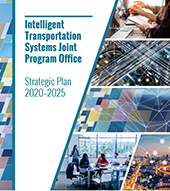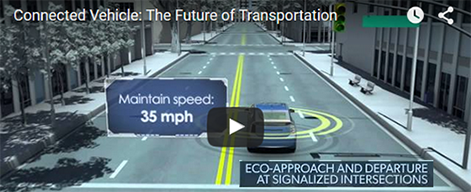Research Archive
Intelligent Network Flow Optimization (INFLO)
Intelligent Network Flow Optimization is a collection of high-priority transformative applications that relate to improving roadway throughput and reducing crashes through the use of frequently collected and rapidly disseminated multisource data drawn from connected vehicles, travelers, and infrastructure.
Research Plan
Advancing applications for intelligent network flow optimization can offer important system-wide benefits to traffic flow and safety. The Intelligent Network Flow Optimization (INFLO) bundle consists of applications related to queue warning, speed harmonization, and cooperative, adaptive cruise control. Current practices for queue detection and warning and speed harmonization are fundamentally limited by their exclusive reliance upon infrastructure- based detection and warning. This imposes a number of limitations on the system, impacting its ability to:
- Locate and distribute queue warnings sufficiently along a facility and ensure that generated warnings are received by drivers
- Obtain sufficient traffic and road weather data to be able to produce accurate warnings
- Operate for sufficient periods in the day to provide warnings whenever queues occur
- Target appropriate speed recommendations to specific portions of the facility and ensure that generated speed recommendations are received by drivers
- Obtain sufficient traffic and road weather data to be able to produce accurate speed recommendations
- Operate for sufficient periods in the day to provide speed guidance whenever the need may arise.
In addition, cooperative adaptive cruise control is reliant upon yet-to-be-deployed connected vehicle technologies.
A connected vehicle system is both vehicle- and infrastructure-based and has the potential to provide a broader and more dynamic set of data and data exchange that will support the INFLO applications in a manner that will addresses today’s limitations.
The three applications that comprise INFLO include:
- Queue Warning (Q-WARN): The objective of Q-WARN is to provide a vehicle operator with sufficient warning of an impending queue backup in order to brake safely, change lanes, or modify the route such that secondary collisions can be minimized or even eliminated. It is distinct from collision warning, which pertains to events or conditions that require immediate or emergency actions. Queue warnings are provided in order to reduce the likelihood of the formation of such emergency events.
A queue backup can occur due to a number of conditions, including:
- Daily recurring congestion caused by bottlenecks
- Work zones, which typically cause bottlenecks
- Incidents, which, depending on traffic flow, lead to bottlenecks
- Weather conditions, including icing, low visibility, sun angles, and high wind
- Exit ramp spillovers onto freeways due to surface street traffic conditions
In all cases, queuing is a result of significant downstream speed reductions or stopped traffic and can occur with freeways, arterials, and rural roads. Queuing conditions present significant safety concerns; in particular, the increased potential for rear-end collisions. They also present disruptions to traffic throughput by introducing shockwaves into the upstream traffic flow. A queue warning system will be successful at minimizing secondary collisions and the resulting traffic flow shockwaves by being able to: rapidly detect the location, duration, and length of a queue propagation; formulate an appropriate response plan for approaching vehicles; and disseminate such information to the approaching vehicles readily and in an actionable manner.
The INFLO Q-WARN application concept aims to minimize the occurrence and impact of traffic queues by using connected vehicle technologies, including vehicle-to-infrastructure (V2I) and vehicle-to-vehicle (V2V) communications, to enable vehicles within the queue event to automatically broadcast their queued status information (e.g., rapid deceleration, disabled status, lane location) to nearby upstream vehicles and to infrastructure-based central entities (such as the TMC). The conceptual Q-WARN application performs two essential tasks: queue determination (detection and/or prediction) and queue information dissemination. In order to perform these tasks, Q-WARN solutions can be vehicle-based or infrastructure-based or utilize a combination of each.
It is important to note that the Q-WARN application concept is not intended to operate as a crash avoidance system (e.g., like the forward collision warning [FCW] safety application). In contrast to such systems, Q-WARN will engage well in advance of any potential crash situation, providing messages and information to the driver in order to minimize the likelihood of his needing to take crash avoidance or mitigation actions later. As such, Q-WARN-related driver communication will always give priority to crash avoidance/ mitigation safety applications when such applications determine that a safety-related warning is necessary.
- Dynamic Speed Harmonization (SPD-HARM): The objective of SPD-HARM is to dynamically adjust and coordinate maximum appropriate vehicle speeds in response to downstream congestion, incidents, and weather or road conditions in order to maximize traffic throughput and reduce crashes. A dynamic SPD-HARM system will be successful at managing upstream traffic flow by being able to: reliably detect the location, type, and intensity of downstream congestion (or other relevant) conditions; formulate an appropriate response plan (i.e., vehicle speed and/or lane recommendations) for approaching vehicles; and disseminate such information to upstream vehicles readily and in a manner which achieves an effective rate of compliance. Improved safety results, in terms of reduced crash rates and less severe crashes, have shown to be the most significant and consistent achievements across deployments that exist today at some level. In addition, SPD-HARM techniques promote reduced vehicle speeds and speed variance, especially in unsafe driving conditions; support modest improvements in throughput; and have a moderately positive impact on travel time reliability. There are three key factors that contribute to the operation of an effective speed harmonization system. The first factor is the availability of information on the prevailing condition on the field. The second factor is the existence of a reliable strategy for the speed limit selection. The last factor is the flow of information from the field to decision making center and vice versa.
Research and experimental evidence has consistently demonstrated that by reducing speed variability among vehicles, especially in near-onset flow breakdown conditions, traffic throughput is improved, flow breakdown formation is delayed or even eliminated, and collisions and severity of collisions are reduced. The INFLO SPD-HARM application concept aims to realize these benefits by utilizing connected vehicle V2V and V2I communication to detect the precipitating roadway or congestion conditions that might necessitate speed harmonization, to generate the appropriate response plans and speed recommendation strategies for upstream traffic, and to broadcast such recommendations to the affected vehicles.
- Cooperative Adaptive Cruise Control (CACC): The objective of CACC is to dynamically and automatically coordinate cruise control speeds among platooning vehicles in order to significantly increase traffic throughput. By tightly coordinating in-platoon vehicle movements, headways among vehicles can be significantly reduced, resulting in a smoothing of traffic flow and an improvement in traffic flow stability. Additionally, by reducing drag, shorter headways can result in improved fuel economy providing the environmental benefits of lowered energy consumption and reduced greenhouse gas emissions.
The CACC operational concept represents an evolutionary advancement of conventional cruise control (CCC) systems and adaptive cruise control (ACC) systems by utilizing V2V and V2I communication to automatically synchronize the movements of many vehicles within a platoon. As with SPD-HARM and Q-WARN, CACC- related driver communication will always give priority to crash avoidance/mitigation safety applications when such applications determine that a safety-related warning is necessary.
Because the INFLO applications are so closely linked, the effectiveness of each can be improved by taking advantage of the benefits to traffic flow and safety that the others provide. In fact, research-to-date has shown that the most successful implementations have been those that combine multiple different freeway management control applications. For example, SPD-HARM benefits Q-WARN by slowing and managing upstream traffic, thus reducing the risk of secondary collisions. CACC benefits SPD-HARM by providing a mechanism for harmonizing traffic flow and reducing or mitigating acceleration variability. Q-WARN benefits CACC by providing the platoon sufficient notification of an impending queue to effectively manage a response.
Importantly, SPD-HARM and Q-WARN are technologies that can be implemented in the near-term. Their benefits are optimized when implemented as infrastructure-based applications that reside at a central entity such as a Traffic Management Center (TMC) as the TMC system has broader visibility into the traffic state, allowing operators to implement a more proactive approach for predicting queues and congestion.
In addition to the benefits of deploying the three bundled INFLO mobility applications in concert, the applications would also benefit from integrating with other applications, including safety systems like electronic stability control (ESC) systems, night vision systems, curve speed warning systems, lane departure warning systems, alcohol monitoring systems, brake assist systems, steering assist systems, forward collision warning (FCW) systems, and pre-crash sensing systems. Coordination with ramp metering systems would also help provide the INFLO applications a better connection with the overall transportation network. Finally, integrating the INFLO applications with Advanced Traveler Information Systems (ATIS) would provide road users enhanced information about the state of the transportation system, pre-trip planning, route-making, and incident avoidance.











